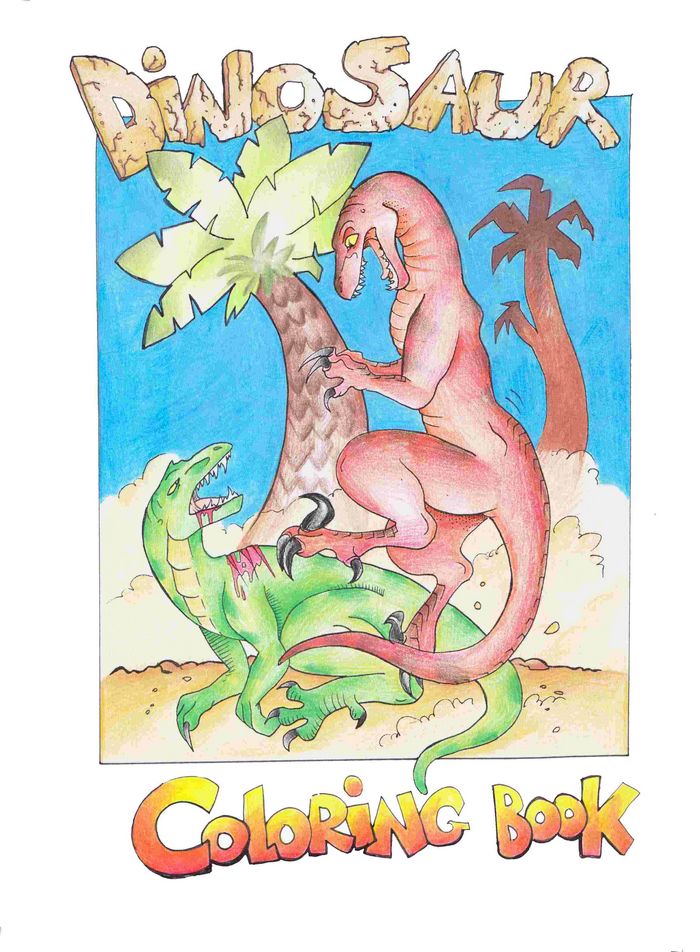Back in 1944 British bombers flew a mission over Munich, deep in the heart of Germany, and one of their bomb falls on the palaeontology museum which blew up Spinosaurus and much else besides. What a tragedy. Fortunately detailed drawings and descriptions survived and back in 2000 some photographs of the original fossils came to light, which were enormously helpful when reconstructing what the bombers had destroyed. Read on to find out more.
When I started researching Spinosaurus for this blog I was reminded of a cartoon drawn by Henrik Tomenius of Poorly Drawn Dinosaurs.com. In it, T rex attacks a family of Hadrosaurs. They manage to escape through the swamps, but T rex gets bogged down, drowns, and turns into oil over many millions of years. It’s war time, and the oil from T Rex gets put into the fuel tank of a bomber, which then drops bombs on a museum in which the bones of a family of Hadrosaurs we met earlier are mounted. They are blown to little bits. T Rex's revenge. The End
Feeling lazy? Watch the video instead.
The bomb fell on the palaeontology museum
I tell you that story about the cartoon because it kind of played out in real life. Today is the 24th April, which is the day of reckoning for the holotype specimen of Spinosaurus. Back in 1944 British bombers flew a mission over Munich, deep in the heart of Germany, and one of their bomb fell on the palaeontology museum which blew up Spinosaurus and much else besides. What a tragedy. Fortunately detailed drawings and descriptions survived and back in 2000 some photographs of the original fossils came to light, which were enormously helpful when reconstructing what the bombers had destroyed.
If we haven’t met, my name is Gerald Davie – I am the Dinoman. I head up the DinoZone – which has an online presence and a physical presence at the DinoZone Dinosaur Park and Geocentre. If you are in the area, pay us a visit. If you are in cyberspace, pay us a visit. The best way to do this is to check out our Facebook page, our Instagram page, and read our blogs right here.
First discovered in Egypt back in 1912
Right, lets get back to Spinosaurus. Spinosaurus was a genus of spinosaurid dinosaur that lived in what now is North Africa during the Late Cretaceous period, about 99 to 93.5 million years ago. The creature was first discovered in Egypt back in 1912 by Richard Markgraf, and described and named by German palaeontologist Ernst Stromer in 1915 - with him naming the new dinosaur Spinosaurus aegytpiacus. Another species of Spinosaur, S. maroccanus was described by Dale Russell in 1996, the new classification based on the length of its neck vertebrae. There is some controversy around this new ‘species’ – it may in fact just be a Spinosaurus aegyptiacus.
Those long spines on its back
Spinosaurus is the longest known terrestrial carnivore; other large carnivores comparable to Spinosaurus include theropods such as Tyrannosaurus, Giganotosaurus and Carcharodontosaurus. Spinosaurus is estimated to have reached 14 metres (46 ft) in length and 7.4 metric tons in body mass. It had long, low and narrow skull, much like a modern crocodile and it had straight teeth without serrations. It had large, strong forelimbs with three-fingered hands with the first claw being enlarged. What makes Spinosaurus “Spinosaurus” are those long spines on its back, which were extensions of the vertebrae. These spines grew up to 1.65 m in length, which is almost the height of a human. Current thinking is that skin connected the spines to create a sail, although some palaeontologists think that the spines were covered in fat to form a hump. And what a big hump that would have been. It had a small hip bone, with short legs in relation to the rest of its body. At the non-business end of the animal was a long, deep, narrow tail which formed a flexible fin which would have been marvellous for swimming.
Used to chase of rivals
Spinosaurus ate fish, but probably much else besides. It spent its life in and out of the water, similar to how crocodiles live today. Its sail was possibly used for regulating its body temperature, and maybe even for display to attract mates and chase of rivals. Tidal flats and mangrove swamps were its home, which it shared with other dinosaurs, fish, lizards, turtles, pterosaurs and plesiosaurs.
Other specimens are housed in the:
- Canadian Museum of Nature, Ottawa
- Muséum National d'Histoire Naturelle, Paris
- Office National des Mines, Tunis
- University of Chicago Palaeontological Collection
- Civic Natural History Museum, Milan
- Natural History Museum, London
And there I shall leave it. Remember to leave your comments, subscribe to our newsletter, download the free colouring book, otherwise you will miss out on all this amazing content on dinosaurs, palaeontologists and palaeontology. And just as the bombs that rained down on Spinosaurus was a tragedy, so would missing out on the DinoZone content would be a tragedy...
And seeing that you are here, grab yourself a copy of our free colouring book, which is full of wonderful dinosaurs and other Mesozoic creatures for you to bring back to life.



